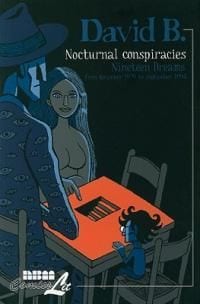
In 1899, Sigmund Freud published a book called The Interpretation of Dreams chronicling his theory that dreams serve as an exceptional tool for uncovering unconscious mental functions. One hundred and ten years later, it seem dreams continue to be a mainstay in art, film, and literature, with the years in between seeing the use of dreams or dream-influenced works in artists and writers such as Salvador Dali, Jean Cocteau, and David Lynch. With this in mind, it comes as somewhat of a surprise that there haven’t been more comics dealing with the subject of dreams. It seems that comics would be a medium particularly well-suited to wading through both the bizarre image and word landscapes of dreams, and with the notable exception of Neil Gaiman’s Sandman comic series, there isn’t that much out there in the way of dream-related comics. This is why it’s exciting to encounter a work like David B.’s Nocturnal Conspiracies, as it gives us an account of just how dreams might be dealt with in the graphic novel medium.
The book follows 19 of David B.’s dreams. Most of these dream episodes last about five pages and are numbered. There is no transition between dreams and sometimes the only way you know that you have moved from one dream to the next is a number and new title on the top of the following page. Following the number and title of the dream, there is usually a description of about when the dream occurred, but other than that David B. makes no attempt to situate the dream in a larger context. The dreams are given as reports with no analysis. In fact, readers get the sense that they are having the dream themselves, as they are equally lost and unaware in these curious dream worlds. These dream comics start without warning and end just as abruptly. For instance, in one episode called “The Bed,” David B. recounts being pursued by a killer in an orchard, then moves to his chance meeting with an Arabian prince followed by the dream commencing with the narrator being chased by a bull and hiding away in a bed made out of rocks.
David B. is a member of L’Association, a group of French comic artists who started their own alternative comics around 1990. In 2005, the full English translation of Epileptic was released by Pantheon’s comic division and almost immediately became a great success. Following its release, David B. received a number of awards including the Ignatz award for Outstanding Artist. A largely autobiographical work, Epileptic is a much different work than Nocturnal Conspiracies both in tone and subject matter, but still follows a lot of similar themes in terms of fantasy life and dreams, as well as containing a similar drawing style. But whereas Epileptic was both narrative and explicitly personal in style, Nocturnal Conspiracies is episodic and topical.
While different in structure and tone, Nocturnal Conspiracies does share a lot with the earlier book’s drawing style. In each of the books, the art can be both simplistic and fantastical. The pages are filled with grotesque monsters as well as complex and foreboding architecture. If anything, Nocturnal Conspiracies reaffirms the idea that comics can stand in as art, while still maintaining a distinct style of their own.
While the art is certainly one of the biggest draws of David B.’s new work, what truly makes it a distinct and interesting contribution to the graphic novel community and beyond is both the subject matter of dreams themselves and the way in which those dreams are treated. While Freud advocated the rigorous analysis of dreams to better understand human beings and their unconscious drives, David B. resists this approach and instead presents just the dreams themselves. By resisting interpretation of the dreams portrayed, David B. makes the implicit argument that there is something about these dreams that is valuable in and of themselves. In the short introduction, the only text of the book that is not a dream itself, David B. notes that “the repetition of [these] themes made me want to draw those dreams. I love their chaotic and poetic structure. I love their mysterious logic. I love their enigmas without solutions. Each of these dreams is a chapter in my dark novel.” Instead of thinking about how dreams may figure or be used in other artistic forms, David B. argues that they have a structure and logic all their own, distinct from both creative and real-world configurations.
As memoir comics and comics reflecting on their own creative process continue in popularity, it seems that comics reflecting on the process of dreaming may be the perfect complement to further understanding oneself and one’s creative process. However, as Nocturnal Conspiracies argues, dreams might also be their own autonomous art forms, with meanings separate from their dreamer, worthwhile in and of themselves.

![Call for Papers: All Things Reconsidered [MUSIC] May-August 2024](https://www.popmatters.com/wp-content/uploads/2024/04/all-things-reconsidered-call-music-may-2024-720x380.jpg)



